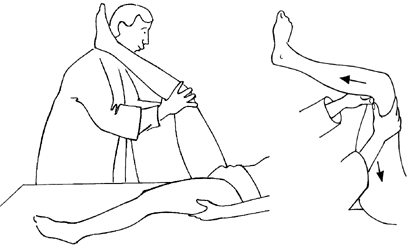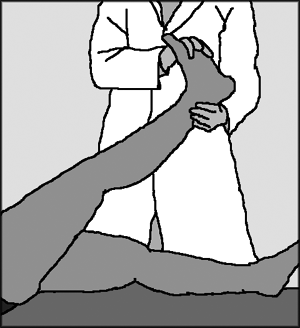Larry Han, AP
個人在治療雷諾氏症的觀察和體驗,韓羅維 美國佛羅里達州中醫師
I have been seeing patients with Raynaud’s Disease for long time, realized it can be difficult and complicate, you see common symptoms yet every single case has its own causes, this is why that I am always amazed and remind myself to always keeping the humble and learning attitude about the disease. Often times patient come to clinic believing that they have the disease, when they learned all they have was just merely cold hands and feet, turn out to be a wonderful ending for both patient and myself.
Acral artery spasms also known as Raynaud’s Disease, it is one type of neurological, vascular disorders (peripheral vascular dysregulation). Cause is unclear yet it is related to the autonomic nervous system dysfunctions.
When secondary to certain diseases, it is called Raynaud’s phenomenon. The disease often occurs in young women, especially those who are easy to get nervous. Exposed to cold air, or drastic emotional change can induce attack.
Diagnosis: slow onset, usually after exposure to cold environment, especially after the finger (toe) in contact with the cold water. Often seen in distal extremities, mainly the fingers. Pale white fingers are symmetry, then cyanosis can be noticed. often starting from the fingertips, gradually move to the fingers, palm. accompanied by localized cold, numbness, pricking-like pain, or other paresthesia.
Radial artery or dorsalis pedis pulse can be normal or weaken, attack remission after several minutes. Skin turns to flushing then returned to normal, so as the skin temperature. There are no particular symptoms other than cold hands or feet during remission.
Affected areas can also be seen in other parts of the body, such as the nose, lips, ears and even nipples and so on.
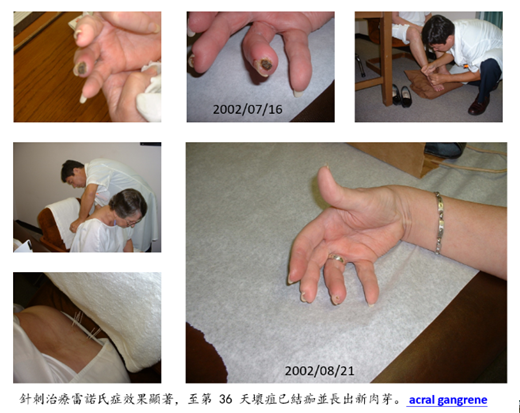
【See Above pictures. Acupuncture offers effective and significant result in treating Raynaud’s disease, gangrene is diminishing with scab and new granulation grown on the 36th day from the beginning of the treatment shown in picture. 】
Recurrence 復發的治療
In July 2012, same patient had another serious attack of Raynaud’s Disease. Again, it was acupuncture helped with the situation, see following dated pictures.
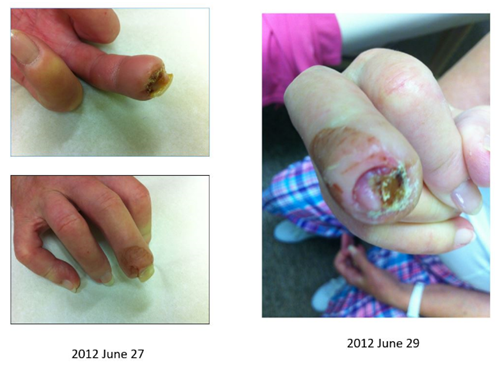
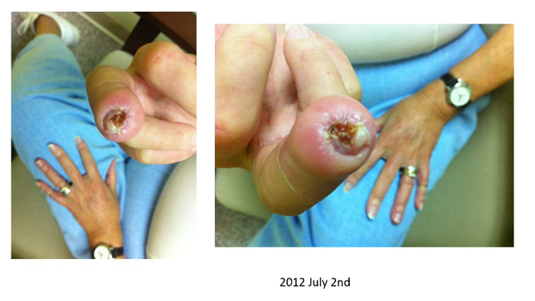
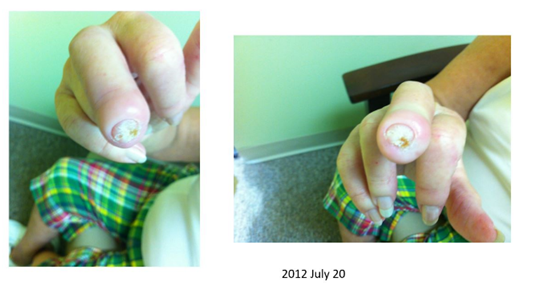
Acu-points used in acupuncture treatment:
- Jia-Ji treatment:
Primary acu-point should be in the lower cervical, upper thoracic as well as lumbar region.
- Localized distribution acu-point:外關SJ5 ,合谷 LI4,後溪 SI3 ,足三里 ST36, 太溪KI3 ,太衝 LR3 ,俠溪 GB43 。
Operation: reducing method.
- Acupuncture with Elec-stimulation:
Prescription:曲池 LI11 ,外關 SJ5 ,內八邪,太谿 KI3 ,太衝 LR3,
足三里 ST36。
use sparse continues wave,frequency 1 Hz, negative connect to distal acu-point and positive to the proximal,15~30 minutes in each treatment.
- Personal experience:
First, acupuncture can quickly act on the pain, neurotransmitters such as catecholamine’s can also reduce the stress and anxiety induced phenomena’s. As the disease relapsed or during remission stage, herbal treatment can be considered.
I some time prescribed herbal prescription called Wen-Yang Tong-Mai-Yin, was developed by Professor Gao Weibin, I used herbs to help consolidate and effectiveness of the treatment, or to use it for those who cannot come to continue the acupuncture treatments.
Formula usually consist of Fu-Zi (Aconite), Wu-Zhu-Yu (Evodia), Huang-Qi (Astragalus), Dang-Shen (Codonopsis), Dan-Shen (Salvia), Chi-Shao (TPG), Dang-Gui (Angelica), Gui-Zhi (cassia twig), as well as others to be added base on patient’s condition.
Pharmacological analysis of these herbs:
Fu-Zi (Aconite) and Wu-Zhu-Yu (Evodia) both Belongs to tonify Yang herbs that containing higenamine with β-adrenergic receptor agonists like effects, worked to expand the skeletal muscle blood vessels, reducing peripheral vascular resistance.
Huang-Qi (Astragalus) and Dang-Shen (Codonopsis) can enhance adrenal function, improve body’s adaptability, expand blood vessels, reducing vascular resistance.
Salvia, TPG expansion limbs blood vessels and improve peripheral circulation.
When adding together Angelica, cassia twig and Evodia can effectively increase skin temperatures.
【Raynaud’s Disease cause and treatment from a western medicine point of view】
Presently the cause for Renault disease is still unclear, overreaction to cold environment, anxiety and emotional change seems also have associated with the condition. Vasospasm may cause long-term harden and thickening of the small arteries can further worsen the situation.
Primary Raynaud’s disease
Also known as Raynaud’s disease, the majority of Renault’s disease fall into this category, the cause is unknown, there is no specific predisposing conditions.
The second category of Raynaud’s disease, also known as Raynaud’s phenomenon, which has a specific incidence of the condition, although cases number is relatively small, but symptoms are much more severe. Usually pathogenesis seen in the middle age, about 40 years old.
Cause for Raynaud’s phenomenon may include the following:
Connective tissue disease: for example, scleroderma patients can also have Raynaud’s phenomenon. Other risk includes lupus, rheumatoid arthritis, Sjogren’s syndrome.
Artery disease: :動脈硬化 atherosclerosis,伯格氏病 Buerger’s ‘s disease, 原發性肺動脈高壓 primary pulmonary hypertension。
Carpal tunnel syndrome. Long hours of repeating
Long-term and repeated hand exertion, such as the piano practicing, continuous using pneumatic tools.
Smoking, side effects of certain drugs such as beta blockers; migraine drugs containing ergotamine or sumatriptan; drugs for ADHD or drugs for inattentions, even cold medicine, etc. are likely to cause vasoconstriction phenomenon and leading to attack.
Injuries: wrist and ankle contusion, surgery and frostbite may also induce the disease.
Primary Raynaud’s disease morbidity and risk factors include:
Gender: Women were more common
Age: between 15 to 30 years old
Climate: Cool Region
Family history: 1/3 of patient’s first-degree relatives has higher incidence, such as parents, siblings, children, etc.
Risk factors for the second category which is the Raynaud’s phenomenon are:
Related diseases: scleroderma or lupus erythematosus.
Certain occupations: Some job can cause repeated trauma, such as vibration-type tools.
Hazardous substances: smoking, drugs, chemicals, such as vinyl chloride vinyl chloride.
Complications:
Rare and severe Raynaud’s disease may lead to a permanent fingers and toes deformity, resulting from long-termed blood supply reduction.
When attacking area is having a completely blood supply cut off, skin ulcers and gangrene will happen immediately. Ulcers and gangrene are difficult to treat, usually ended with amputation.
Prognosis
Once Raynaud symptoms (primary or secondary) has been confirmed, patient would have to go through life time treatment. In the case of Renault phenomenon, the situation is more complicated and difficult; patients usually develop adaptation to the drug, not only reduce the efficacy, but the symptoms will be more frequent and more severe.
Treatment and Research
The current study is primarily focused on an enzyme that connect with vasoconstrictions called tyrosine kinase (human proteins), it is associated with heredity.
There are several new treatment options are being conducted, including BOTOX® therapy, Viagra®, traditional Chinese medicines such as ginkgo biloba, and St. John’s wort.
Prognosis for Raynaud ‘s Disease
Once primary or secondary Raynaud’s develops, the condition usually must be managed over the course of the patient’s lifetime. Although Raynaud’s attacks can be stressful, it is important to remain patient, follow your doctor’s instructions, and be open to other therapies if necessary.
Patients who have secondary Raynaud’s may have an especially difficult time. Treatment options often require adjustments because medications can become ineffective over time and the attacks can occur with more frequency and severity.
Raynaud’s Disease Research
Researchers are studying possible causes for primary Raynaud’s. Ongoing studies are focused on genetic links and on the role that a protein called tyrosine kinase (PTK; an enzyme involved in constricting blood vessels) may play in development of the condition.
A number of new treatment options also are being studied. These treatments include using botulinum toxin injection therapy (BOTOX® therapy), Viagra®, and herbal therapies (e.g., ginkgo biloba, St. John’s wort) to treat Raynaud’s disease.
Publication Review by: Stanley J. Swierzewski, III, M.D.
Published: 03 Nov 2008
Last Modified: 21 Sep 2010
http://www.healthcommunities.com/raynauds-disease/prognosis-research.shtml
韓羅維 Larry Han, AP
February 14, 2016
